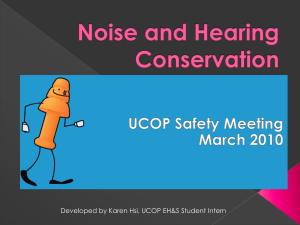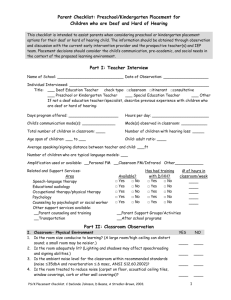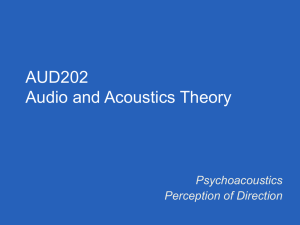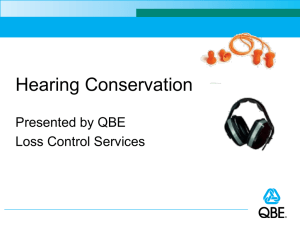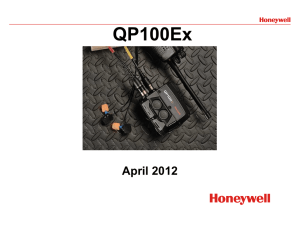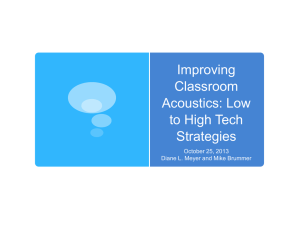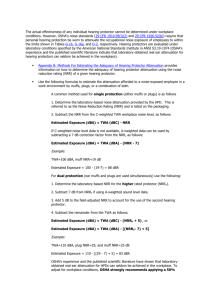Hearing Conservation - UA SafeState
advertisement
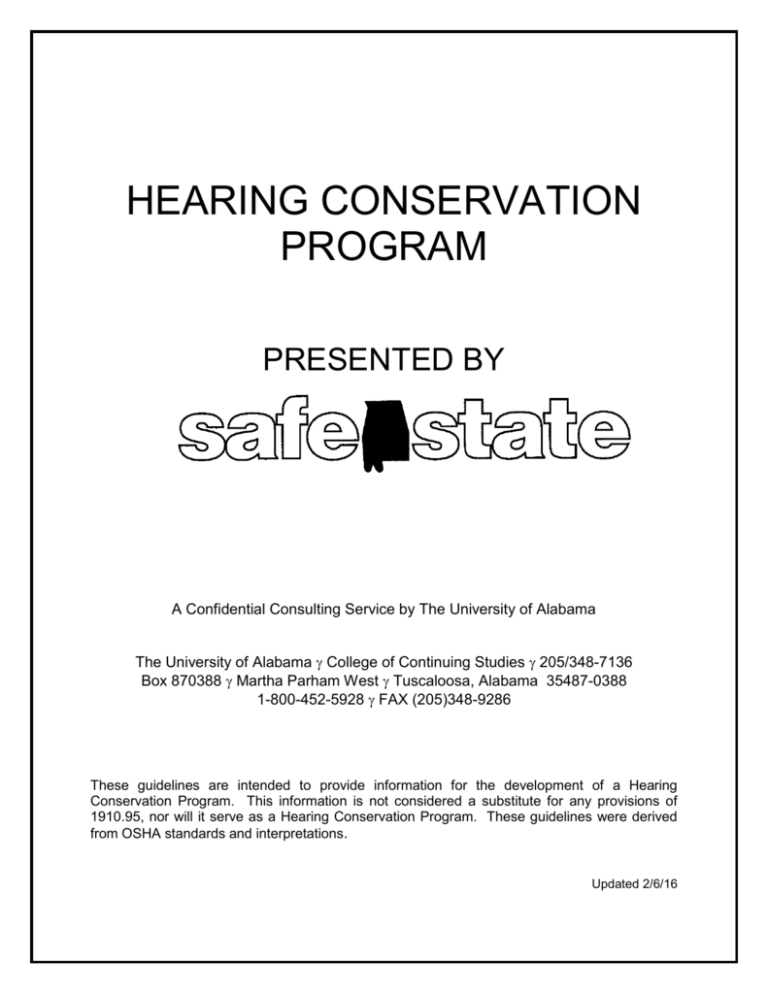
HEARING CONSERVATION PROGRAM PRESENTED BY A Confidential Consulting Service by The University of Alabama The University of Alabama College of Continuing Studies 205/348-7136 Box 870388 Martha Parham West Tuscaloosa, Alabama 35487-0388 1-800-452-5928 FAX (205)348-9286 These guidelines are intended to provide information for the development of a Hearing Conservation Program. This information is not considered a substitute for any provisions of 1910.95, nor will it serve as a Hearing Conservation Program. These guidelines were derived from OSHA standards and interpretations. Updated 2/6/16 1 HEARING CONSERVATION PROGRAM (Company Name) This Hearing Conservation Program is to protect our employees from the harmful effects of noise. The program shall consist of noise monitoring, employee training, audiometric testing with appropriate medical surveillance, utilization of hearing protection and engineering controls, and record keeping. The program will include all employees exposed to noise levels in excess of the action level of dB(A) on an hour basis. The program shall be administered by . The program administrator has the full authority and responsibility to implement this program. A copy of 1910.95, Appendix A, must be posted on the Safety board for reference. The following job categories in the list are or have been determined to have employee exposures to noise in excess of dB(A) on a(n) hour basis. These employees will be included in the hearing conservation program. DEPARTMENT JOB TITLE EXPOSURE LEVEL The following job categories listed have employee exposure to noise in excess of the OSHA permissible exposure level of dB(A) on a (n) hour basis. DEPARTMENT JOB TITLE 1 EXPOSURE LEVEL HEARING PROTECTION Hearing protection shall be provided to all employees exposed to noise levels in excess of the action level. The use of hearing protection will be required for these same employees if they are exposed to noise levels in excess of the permissible exposure level, have a documented Standard Threshold Shift, or have not had a baseline audiogram and employed for 6 months or more. (HIGHLY RECOMMEND ANYONE OVER THE ACTION LEVEL BE REQUIRED TO WEAR HEARING PROTECTION). The effectiveness of the hearing protection will be calculated by using the OSHA field attenuation formula in Appendix B. If the attenuation does not reduce employee exposure levels below the PEL for those who have had a Standard Threshold Shift, a higher form of protection will be utilized. The use of double protection, earplugs and muffs, can add an additional 5 dB (A) to the attenuation value of the highest rated (NRR) protector. A variety of hearing protection is available at no cost to our employees. This consists of two types in any combination of foam plugs, inserts, or earmuffs. We provide: TYPE NRR 1. 2. ADMINISTRATIVE AND ENGINEERING CONTROLS (if needed) All locations where noise exposure levels are in excess of the permissible exposure level of dB(A) shall have effective administrative or engineering controls to reduce employee exposure to noise. Engineering controls may include enclosures and barriers. Administrative controls may include rotation of employees to quiet areas during the shift. These controls shall be implemented with the assistance of an acoustical engineer or industrial hygienist. The controls shall be properly maintained to ensure their continued effectiveness. The following engineering controls have been instituted. Noise Level CONTROL 2 LOCATION NOISE MONITORING An industrial hygienist will conduct noise monitoring. Noise monitoring will be performed whenever a condition exists resulting in an increase of employee noise’s exposure. Employees or their representatives will be given an opportunity to observe the monitoring. Any employee exposed to noise levels in excess of the action level shall be informed of their exposure level and provided training as described later. AUDIOMETRIC TESTING All employees exposed to noise levels in excess of the action level shall be included in an audiometric testing program. The audiometric testing is performed by All new employees in job categories exposed at the Action Level or higher are given a baseline audiogram. If this cannot be arranged, they must be given a baseline within six months unless a van service is used. Then it must be given within one year. Audiometric testing will fulfill the following requirements: 1. Performed by a trained audiometric technician. 2. Performed using properly calibrated audiometer (annual electronic and acoustic calibration, or biologic calibration prior to daily use). 3. Performed in a test booth meeting the background noise requirements of 29 CFR 1910.95, Appendix D. 4. Performed following fourteen hours of no occupational noise exposure (quiet time). Hearing protectors may be used to achieve this required time. Employees will be notified of this requirement and asked to avoid high noise levels during this period. 5. Evaluated and compared to any existing baseline. 6. Re-tested within thirty days by an audiologist or physician following any audiogram identified as a standard threshold shift. 7. Employees must be notified of audiogram results within twenty-one days if standard threshold shift is identified. 8. Done at no cost to employees. A standard threshold shift is the loss of hearing relative to the baseline audiogram of an average of 10 dB or more at 2000, 3000, and 4000 Hz in either ear. If a standard threshold shift does occur, the employee will be immediately retested. The employee is 3 now required to wear hearing protection. If he is already wearing hearing protection, he will be refitted and retrained in the use of hearing protectors and provided with hearing protectors offering higher attenuation. He will be referred to a licensed physician for evaluation. A standard threshold shift may be recorded as an occupational illness on the OSHA 300 log (see recordkeeping). TRAINING All employees and supervisors in areas where noise exposure levels exceed the action level shall be trained on an annual basis and shall be updated to be consistent with changes in protective equipment and work practices. The training shall include the following: 1. The effects of excess noise upon the ear. (Mandatory) 2. Types of hearing protectors available and their purpose, proper use, care, and fitting including advantages and disadvantages of each type. (Mandatory) 3. The purpose of audiometric testing and an explanation of test procedures. (Mandatory) 4. The current and future efforts of the company to reduce noise exposures by engineering and/or administrative controls. (Recommended) 5. Specific machinery that can cause excessive noise exposure. (Recommended) 6. The contents of the noise standard and its appendices (29 CFR 1910.95). (Recommended) RECORDKEEPING The program administrator is responsible for maintaining all records. Employees may access these at anytime. The following records will be maintained for the specified time period: 1. Audiograms - (Required for duration of employment, recommend for duration of employment plus thirty years). A. Name and job classification. B. Date of audiogram. C. Examiner name. (Recommend you include the qualifications also). 4 D. Manufacturer and model number of equipment. E. Audiometer calibration. i. ii. iii. 2. Type of calibration. Date. Results (numerical). F. Employee's most recent noise exposure assessment. G. Test booth background levels (octave band) and date. Noise monitoring results (two years). A. Name. B. Job classification of employee measured and other employees represented by the measurement. C. Date, locations and results of each measurement. D. Equipment and calibration information. 3. Training documentation - (recommend five years). 4. Notification letter to employee with a Standard Threshold Shift (recommend for length of employment plus thirty years). 5. If an employee’s hearing test (audiogram) reveals that the employee has experienced a work-related Standard Threshold Shift (STS) in hearing in one or both ears, and the employee’s total hearing level is 25 decibels (dB) or more above audiometric zero (averaged at 2000, 3000, and 4000 Hz) in the same ear(s) as the STS, you must record the case on the OSHA 300 Log. 5 TRAINING RECORD Date: _____________________ Employee Name: ______________________ Trainer Name: ________________________ TOPICS COVERED 1. The effects of excess noise upon the ear. 2. Types of hearing protectors available and their purpose, proper use, care, and fitting including advantages and disadvantages of each type. 3. The purpose of audiometric testing and an explanation of test procedures. ___________________________________ Employee Signature ___________________________________ Trainer Signature 6 APPENDIX A – 1910.95 1 APPENDIX B EVALUATION OF THE EFFECTIVENESS OF HEARING PROTECTORS 1 EVALUATION OF THE EFFECTIVENESS OF HEARING PROTECTORS Ear protection for employees is effective in substantially reducing noise exposure. Such protection may be provided as either ear plugs, ear muffs or both. Employers are required by the noise standard to evaluate the sound attenuation provided by ear protectors for the specific environment in which the protector will be used. Evaluation methods that must be used, according to 29 CFR 1910.95(I)(1), are described in Appendix B of the standard. When utilizing the Noise Reduction Rating (NRR) for hearing protectors using a dosimeter that records A-weighted measurements, the following method is used: 1. 2. 3. Convert the A-weighted dose (%) to the TWA Subtract 7 dB from the NRR Subtract the remainder from the A-weighted TWA to obtain the A-weighted TWA under the hearing protector This method determines the laboratory based noise reduction for a given hearing protector. However, in an actual work environment laboratory based attenuation cannot be obtained. Therefore, a 50% safety factor is applied. For example, an employee has an 8-hour TWA noise exposure of 96 dB(A). He used Zee Brand earplugs with an NRR = 31. The field based attenuation is calculated as follows: Approximate Field = Attenuation 31 dB – 7 dB = 12.0 dB 2 (safety factor) A-weighted TWA under the hearing protector = 96 dB(A) – 12 dB = 84 dB(A) When ear muffs (North, NRR=23) are utilized along with ear plugs, an additional 5 dB attenuation may be realized from the better rated hearing protector. In this case the Zee model plugs are better, so do the calculation as above and subtract 5 dB(A). If the muff was better, do the calculation of it, then subtract 5 dB(A). Actual hearing protection under the muff and plugs would then be 79 dB(A). 1

